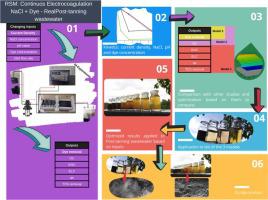Process Safety and Environmental Protection ( IF 6.9 ) Pub Date : 2022-08-05 , DOI: 10.1016/j.psep.2022.08.008 Déborah L. Villaseñor-Basulto , Abudukeremu Kadier , Raghuveer Singh , Ricardo Navarro-Mendoza , Erick Bandala , Juan M. Peralta-Hernández

|
Post-tanning process in the tannery industry generates complex wastewater. Continuous electrocoagulation (EC) with carbon-steel electrodes was used to treat synthetic/post-tanning wastewater. Research surface methodology, based on central composite design (RSM-CCD), was used for variables optimization and analysis of variance (ANOVA) to relate all parameters. Optimal variables were identified as initial pH 3.0, current density 6.4 mA m-2, initial dye concentration 125 mg L-1, NaCl concentration 1,000 mg L-1, and inlet flow rate 176 mL min-1 to produce 71% dye removal, operational costs (OC) 0.05 US$ m-3, power consumption 1.3 kWh m-3, iron consumption 0.05 kg m-3, dye removal capacity per dissolved mg iron (qe) 4.3 mg Dye L-1 C-1 and total dissolved solids (TDS) removal 43.5%. Best process conditions were used to treat real post-tanning wastewater and resulted in carbon oxygen demand (COD) and TDS abatement (23% and 76%, respectively), as well as low OC (0.84 US$ m-3) and energy consumption (20.6 kWh m-3). Pseudo-first-order kinetic model was found fitting experimental results, having electrical energy per order (EEO) of 1 kW h m-1 order-1 with a higher k =1.14 min-1. Scanning electron microscopy analysis suggested the presence of iron nanoparticles within the sludge. All input and output parameters resulted in statistically significant where TDS and qe were the most valued for effective pollutant removal optimization and prevention of TDS increase in treated water. The outcomes of this study suggest EC as a suitable treatment for post-tanning wastewater and further knowledge of steel-carbon EC reactor design and sludge reusing purposes.
中文翻译:

使用电凝聚处理鞣后废水:优化、动力学和沉降分析
制革行业的后制革工艺会产生复杂的废水。采用碳钢电极的连续电凝聚 (EC) 技术用于处理合成/鞣后废水。基于中心复合设计 (RSM-CCD) 的研究表面方法用于变量优化和方差分析 (ANOVA) 以关联所有参数。最佳变量被确定为初始 pH 3.0、电流密度 6.4 mA m -2、初始染料浓度 125 mg L -1、NaCl 浓度 1,000 mg L -1和入口流速 176 mL min -1以产生 71% 的染料去除率,运营成本 (OC) 0.05 美元 m -3,电耗1.3 kWh m -3,铁耗0.05 kg m -3,每溶解mg铁的染料去除能力(qe)4.3 mg染料L -1 C -1和总溶解固体(TDS)去除43.5%。最佳工艺条件用于处理真正的鞣后废水,并导致碳需氧量 (COD) 和 TDS 减少(分别为 23% 和 76%),以及低 OC (0.84 US$ m -3 ) 和能源消耗(20.6 千瓦时米-3)。发现伪一级动力学模型符合实验结果,每级电能(E EO)为 1 kW h m -1级-1具有更高的k =1.14 min -1。扫描电子显微镜分析表明污泥内存在铁纳米颗粒。所有输入和输出参数都具有统计学意义,其中 TDS 和qe对有效污染物去除优化和防止处理水中 TDS 增加最有价值。这项研究的结果表明,EC 作为鞣后废水的合适处理方法,以及对钢碳 EC 反应器设计和污泥再利用目的的进一步了解。











































 京公网安备 11010802027423号
京公网安备 11010802027423号